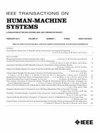基于肌电图的机器人阻力腿部伸展训练最小有效负荷检测
IF 3.5
3区 计算机科学
Q2 COMPUTER SCIENCE, ARTIFICIAL INTELLIGENCE
引用次数: 0
摘要
为了促进肌肉骨骼疾病后的快速康复并提高生活质量,适合每个人身体状况的康复训练非常重要。在股四头肌出现废用性肌肉萎缩的情况下,不适当的训练可能会造成损伤。虽然阻力训练机器人系统已经开发出来,并且可以调节阻力负荷,但目前尚未建立一套系统的检测方法,根据每个人的情况自动调节适当的力量强度。在本研究中,我们开发了一种基于肌电图(EMG)的方法,可确定肌肉生长的最小有效阻力负荷。利用增量阻力负荷集中的综合肌电图(IEMG)模型,我们构建了一种用对数函数确定最小有效阻力负荷的方法。我们使用线驱动腿部伸展训练机器人的慢速训练方案,通过施加递增阻力负荷来测量肌电图和阻力负荷之间的关系,从而测试了我们方法的可行性。结果表明,所提出的模型适用于肌肉质量水平不同的六名年轻受试者和四名老年受试者,而且为每个人得出的负荷都能有效地诱导急性大腿围度扩张,而这正是导致未来肌肉肥大的一个因素。本文章由计算机程序翻译,如有差异,请以英文原文为准。
EMG-Based Detection of Minimum Effective Load With Robotic-Resistance Leg Extensor Training
To promote rapid recovery and quality of life after a musculoskeletal disorder, rehabilitation exercises that are suitable for each individual's physical condition are important. In cases of disuse muscle atrophy of the quadriceps, inappropriate training can cause injury. Although resistance-training robotic systems have been developed and could adjust resistance load, a systematic detection method with appropriate force strength for automatic adjustment for each individual has not yet been established. In the current study, we developed an electromyogram (EMG) based method that determines the minimum effective resistance load for muscle growth. Using an integrated EMG (IEMG) model of incremental resistance load focused, we constructed a method to determine the minimum effective resistance load with logarithmic functions. The feasibility of our method was tested with a slow training protocol using a wire-driven leg extension training robot to measure the relationship between IEMG and resistance load by applying the incremental resistance load. The proposed model was found to be suitable for six young and four elderly subjects with different levels of muscle mass, and the load derived for each person was shown to induce effectively acute thigh circumference expansion, which is a factor leading to future muscle hypertrophy.
求助全文
通过发布文献求助,成功后即可免费获取论文全文。
去求助
来源期刊

IEEE Transactions on Human-Machine Systems
COMPUTER SCIENCE, ARTIFICIAL INTELLIGENCE-COMPUTER SCIENCE, CYBERNETICS
CiteScore
7.10
自引率
11.10%
发文量
136
期刊介绍:
The scope of the IEEE Transactions on Human-Machine Systems includes the fields of human machine systems. It covers human systems and human organizational interactions including cognitive ergonomics, system test and evaluation, and human information processing concerns in systems and organizations.
 求助内容:
求助内容: 应助结果提醒方式:
应助结果提醒方式:


